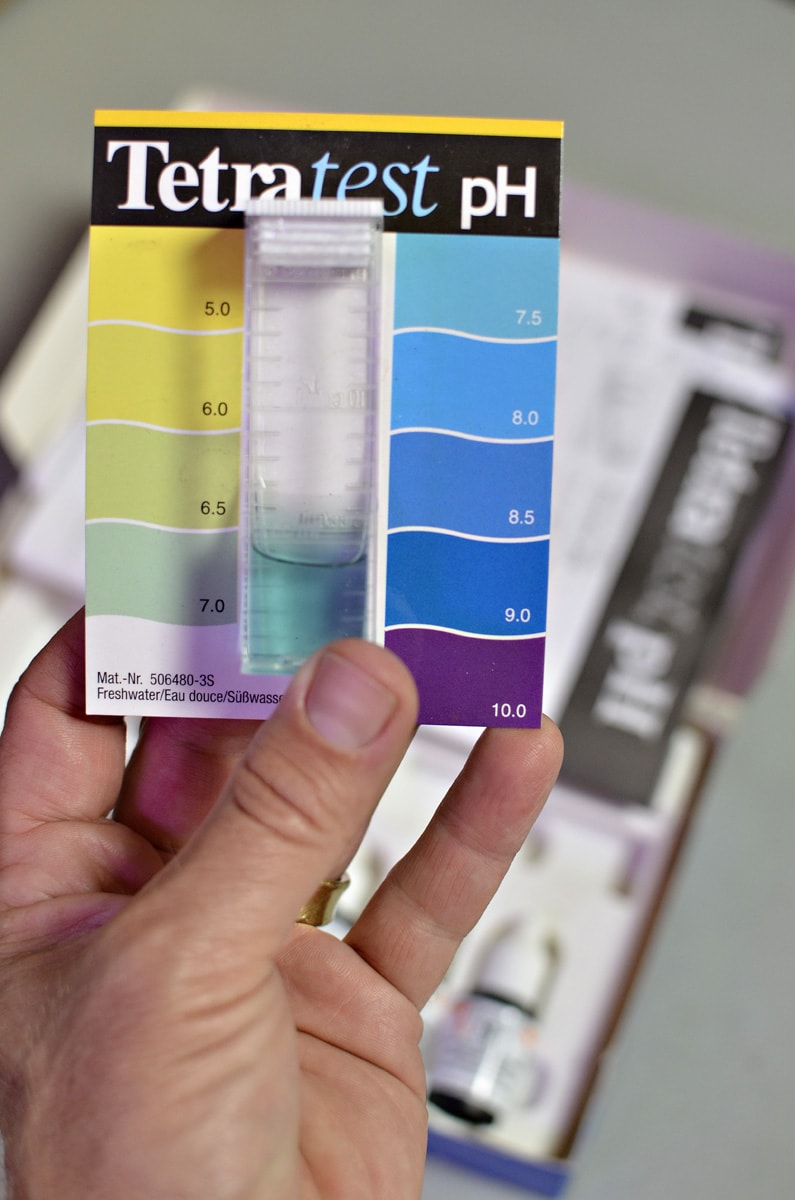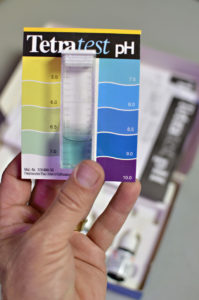Water Quality in Aquaponic Systems – Part 2: pH

 pH is the measure of the concentration or activity of hydrogen ions in a solution — sometimes referred to as “the power of Hydrogen”. It is a key parameter of water quality in both wild and captive ecosystems, and determining factor in what creatures can thrive in those systems. The measurement is charted on a scale of 0 – 14 and corresponds to the ratio of hydrogen ions to hydroxyde ions in a solution. Pure water has a pH of 7, or neutral. Solutions with a pH above 7 are considered basic or alkaline. Those with a pH below 7 are acidic.
pH is the measure of the concentration or activity of hydrogen ions in a solution — sometimes referred to as “the power of Hydrogen”. It is a key parameter of water quality in both wild and captive ecosystems, and determining factor in what creatures can thrive in those systems. The measurement is charted on a scale of 0 – 14 and corresponds to the ratio of hydrogen ions to hydroxyde ions in a solution. Pure water has a pH of 7, or neutral. Solutions with a pH above 7 are considered basic or alkaline. Those with a pH below 7 are acidic.
What is the ideal pH for aquaponics?
Most aquaponic growers shoot for pH range of 6.8 – 7.2. This near neutral range is a compromise among the preferred pH levels of the three main living components of the system: the plants, the fish, and the nitrifying bacteria. Many plants grown in aquaponic systems (lettuce, leafy greens, herbs, tomatoes, peppers) thrive best in a slightly acidic pH range of 5 – 6.5. The fish in these systems often prefer a higher pH. Tilapia, for example, do best in water with a slightly basic pH of 7 – 8. Nitrifying bacteria, the beneficial bacteria living in the bio-filter or grow bed, perform best at more alkaline levels of 8 – 9. The pH is always in flux and never perfectly stable, as there are many elements that affect the pH in captive aquatic systems. For that reason it is a important to monitor the pH level by testing the water at least once a week. Test kits, handheld pH meters, or simple pH test strips (all available at good aquarium shops or online) may be used to keep track of the pH status.
pH in Aquaponics
In an aquaponic system there are many factors at play that can influence the pH. One important establishing factor is the pH and hardness of the water source used to fill the system initially and when topping off for water lost to evaporation and transpiration.
Tap water in this region and in many parts of the US can be quite alkaline with a pH of 8.2 – 8.4, and can have a high to excessive mineral content or hardness (which we will discuss in a subsequent post). Rainwater is typically more acidic and very low in minerals. Depending on where it is collected, the pH of collected rain can be below 5 because of various industrial pollutants in the atmosphere. Well water is another possible source and varies widely in pH and mineral content. For this reason, even if it is known to be potable, it is always wise to have well water tested prior to using it in these systems. Mixing water from various sources may be a good option for achieving an optimal pH — for example, cutting tap water with a rain water or well water.
Another establishing factor is the substrate used in the growbed or net pots in a system. Most commercial fired clay substrates are supposed to be inert. That is, they will have little to zero effect on the water chemistry. Unfortunately, this does not always hold true. Some products may need to be well rinsed and soaked for a period of time to wash away salts and other minerals that will affect the pH. Some commercial substrates, such as those made from recycled glass, require pre-soaking to activate built-in buffers intended to counteract the pH raising elements. There are many options for growing substrate. With all of them it is best to make sure you know how they will influence the pH of the system
What if the pH is Too High?
When the pH is high some very important elements, such as iron, are sequestered and unavailable to the plants. Iron deficiency can be visually diagnosed by the yellowing of leaves, especially at the tips. Some plants have a higher demand for iron than others, and will be more prone to suffering from this condition. In my experience, arugula, kale, and spinach are a few that show this stress when the pH is high and thus the iron unavailable for uptake. A quick remedy for these situations is the use of chelated iron applied as a foliar spray. This product available at most nurseries and garden centers. Preparing a lite dilution and spraying the leaves of the plants once a day for a couple days usually turns the condition around, if it caught early.
What if the pH is too low?
A low pH can also manifest detrimental conditions in our systems. Nitrification, the biological process performed by the beneficial bacteria converting ammonia eventually to nitrate, is of paramount importance and is most efficient at a slightly alkaline pH levels. When the pH drops the nitrification decreases as well. At a pH of 5.5 or below this process is drastically inhibited. Such levels also create stressful conditions for the fish, very often resulting in disease and ultimately fish death.
Managing pH in Aquaponics
There are a number of technique for adjusting the pH into the targeted range. Many “pH UP / pH DOWN” products are on the market that are formulated to either raise the pH if too acidic, or lower the pH if too alkaline. These adjustments should always be performed incrementally to avoid shocking the system and its inhabitants, and also to avoid over-correcting, bringing the pH to dangerously low levels. The effectiveness of the products will vary depending on the buffering capacity of the water and may need to be applied repeatedly over time until the pH is stabilized. Another, probably safer and more effective, option for lowering pH and softening hard water is the use of various organic materials, such as peat, dried Indian almond leaves (Terminalia catappa), or alder cones. Adding these to the water will supply humic and tannic acids that gradually bringing down the pH and soften the water.
These tools for lowering pH aren’t always necessary as the pH will generally come down as the system matures. Though we charge our systems with the slightly alkaline water, in time the pH will begin to drop due to the nitrification and other biological processes at play. To prevent the pH from dropping too low and to keep it within in the targeted range, calcium buffers can be added to the system. Calcium carbonate in the form of crushed oyster shells or coral sand works well to raise the pH and keep it within a safe range. These are usually placed in filter bag and positioned in an area where water will be circulated through the media. Over time these buffers will slowly dissolve and eventually require replacement.
Stay tuned for more on water quality. Next, we will look at water hardness and alkalinity in aquaponic systems.